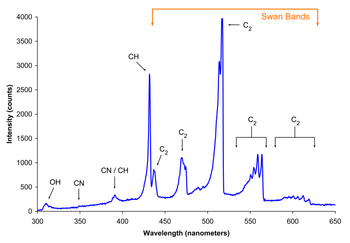Swan band

Swan bands are a characteristic of the spectra of carbon stars, comets and of burning hydrocarbon fuels.[1][2] They are named for the Scottish physicist William Swan who first studied the spectral analysis of radical Diatomic carbon C2 in 1856.[3]
Swan bands consist of several sequences of vibrational bands scattered throughout the visible spectrum.[4]
See also
References
- ^ R.C. Johnson (1927). "The structure and origin of the Swan band spectrum of carbon". Philosophical Transactions of the Royal Society A. 226 (636–646): 157–230. Bibcode:1927RSPTA.226..157J. doi:10.1098/rsta.1927.0005.
- ^ W.E. Pretty (1927). "The Swan band spectrum of carbon". Proceedings of the Physical Society. 40: 71–78. Bibcode:1927PPS....40...71P. doi:10.1088/0959-5309/40/1/313.
- ^ W. Swan (1857). "On the prismatic spectra of the flames of compounds of carbon and hydrogen". Transactions of the Royal Society of Edinburgh. 21: 411–430.
- ^ Robert B. King (1948). "Relative Transition Probabilities of the Swan Bands of Carbon". Astrophysical Journal. 108: 429. Bibcode:1948ApJ...108..429K. doi:10.1086/145078.
